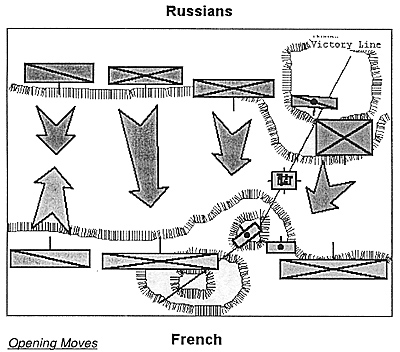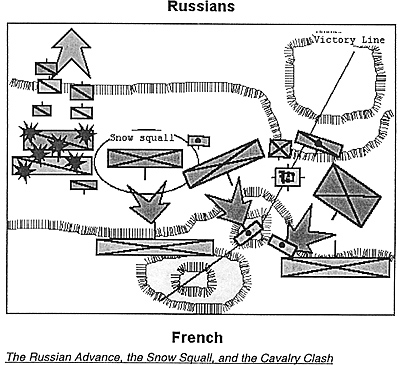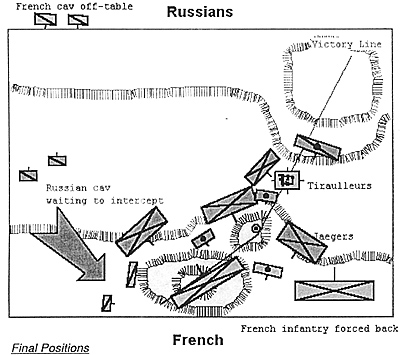 The Two sides set up quickly. This was easy, because the number of units was relatively low, and the setup area of each brigade was already determined.
The Two sides set up quickly. This was easy, because the number of units was relatively low, and the setup area of each brigade was already determined.
The French concentrated both artillery batteries near Windmill Hill itself, and placed one of their elite tirailleur units in the "town". The town would be treated as a single town block: Hard cover vs. shooting, soft cover vs. combat.
The Russians set up with their musketeer units in column, and a strong skirmish screen protecting the jaegers. They began the fateful steps through the snow towards the enemy, while the two heavy batteries opened up on the town.
The cavalry brigades were the first to engage, although the French horse artillery had to retreat precipitously to avoid a sudden charge by one of the Cossack "clouds". From the first, the French had all the advantages, literally crushing even the Russian dragoons with their superior morale (and hot die rolls!). The Russians, failing test after test, were routed back off the table, with two French regiments in hot pursuit. Unfortunately, although the French won one initiative roll after another, they could not manage better than a '2' to rally from pursuit (cavalry pursues on a 1-4 on 1D10), and chased their enemies off the table. They would need an 8-10 to return, and never scored better than a '7'.
The French hussars met with disaster. They were busy wiping out the remaining dragoon unit, when three Russian regiments charged them from all sides, routing them and forcing the gallant Frenchmen to surrender. Some of the surviving Russian horsemen took up position to intercept the French cavalry if they returned, while the rest began a flanking movement around the French left. It was a case of numbers overwhelming quality.
In the center, Dave's brigade steadily plodded forward, absorbing artillery hits, but managing to advance the bulk of their men anyway. Column of Attack is a 1:20 scale set of rules, and each gun model represents a section. Artillery is therefore very powerful - as it should be. A battery firing canister can literally clear its frontage of enemy figures in 1-2 turns, even assuming the targets pass morale to take more punishment. To slow them even more, a sudden snow squall clobbered them for a turn.
However, they eventually clambered up the slopes west of Windmill Hill, to charge into Leval's division. Leval's artillery wreaked havoc on the advancing columns. But there were too many targets, and one charge reached the guns, wiping out the brave gunners.
 The leftmost of Leval's battalions -- the legere demi-brigade -- faced a tough choice: infantry and cavalry in a "double whammy" threatened it. It chose to form square. This would give it advantages vs. cavalry, but leave it vulnerable to infantry. Due to its better morale, it stood for two turns despite losing both rounds of combat (it was heavily outnumbered). However, it then routed back, was hit in the flank by a Cossack unit, and left the table. The French flank had been turned.
The leftmost of Leval's battalions -- the legere demi-brigade -- faced a tough choice: infantry and cavalry in a "double whammy" threatened it. It chose to form square. This would give it advantages vs. cavalry, but leave it vulnerable to infantry. Due to its better morale, it stood for two turns despite losing both rounds of combat (it was heavily outnumbered). However, it then routed back, was hit in the flank by a Cossack unit, and left the table. The French flank had been turned.
On the French right, the jaegers and the remaining musketeer brigade marched across the valley, with two battalions peeling off to mask the town. The heavy batteries fired a few times into the town, but with their -1 penalty they needed 10's to hit, and so did little damage. In the event, the tirailleurs held their log cabins until the end of the game. The Russian guns switched targets, firing over the heads of the jaegers in the valley to heavily damage two of Legrand's demi-brigades.
The French battery on Windmill Hill decimated three Russian musketeer battalions, but the other three pressed on, and eventually forced the French to limber up and evade off the hill.
The jaegers bypassed the town and engaged the rest of Legrand's Division, pinning it while their comrades turned the French flank and gained the ridge.
But, alas, the 4PM hour struck.
The Russians held only two of their four victory areas: their initial hill and Windmill Hill. The town and the south ridge were still in French hands, and therefore a French marginal victory was declared.
 Just for fun we played a few more turns, until about 5:30PM, to see how things would turn out. The Russians continued to push the French steadily back, and eventually got both of their field batteries unlimbered atop Windmill Hill itself, at which point the French generals agreed they would have turned tail and hoped for the Guard to rescue them. The Russian cavalry also charged the French, hitting a couple of weakened battalions and routing them out of the game. However, it was all a mere bagatelle.
Just for fun we played a few more turns, until about 5:30PM, to see how things would turn out. The Russians continued to push the French steadily back, and eventually got both of their field batteries unlimbered atop Windmill Hill itself, at which point the French generals agreed they would have turned tail and hoped for the Guard to rescue them. The Russian cavalry also charged the French, hitting a couple of weakened battalions and routing them out of the game. However, it was all a mere bagatelle.
During the game, the French managed to play all three of their Murphy cards (a snow squall, a Rally! card, and an Out of Command card), while the Russians never got a chance to play a single card - yeesh!
Conclusions from the Playtest
After the game, the five of us had a short brainstorming session. We agreed the scenario went well overall; the French had won a marginal victory, so things looked pretty well balanced. However, we agreed that the French infantry should be grade C, not D, and that Cossacks should not be a skirmish target to shooting; this really made them a bit more effective than they should be. I also decided, after reviewing the historical maps, to make the "town" (a nameless collection of log buildings) merely give soft cover vs. shooting, not hard cover.
Back to Citadel Spring 2002 Table of Contents
Back to Citadel List of Issues
Back to MagWeb Master Magazine List
© Copyright 2002 by Northwest Historical Miniature Gaming Society
This article appears in MagWeb (Magazine Web) on the Internet World Wide Web. Other military history articles and gaming articles are available at http://www.magweb.com